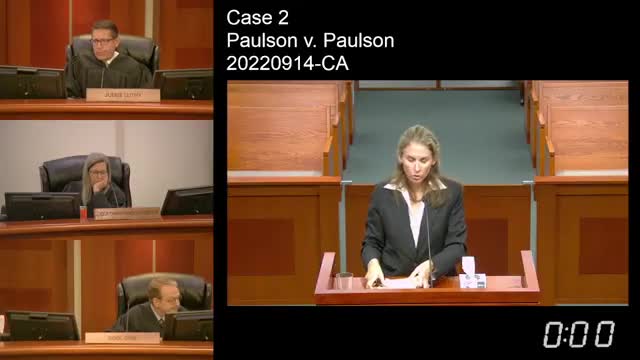Judges Discuss Disqualification and Bias Standards in Ongoing Appeal Case
September 25, 2025 | Utah Court of Appeals Live Stream, Utah Appellate Court, Utah Judicial Branch, Utah
This article was created by AI summarizing key points discussed. AI makes mistakes, so for full details and context, please refer to the video of the full meeting. Please report any errors so we can fix them. Report an error »

In a recent session of the Utah Court of Appeals, the complexities of judicial disqualification took center stage, as judges and attorneys grappled with the nuances of bias and conflict of interest in the ongoing Paulson v. Paulson case. The atmosphere was charged with legal intricacies, as the panel examined whether Judge Johnson should have disclosed a potential conflict of interest and the implications of her decisions on the case.
The discussion began with a query about the necessity for Christopher, one of the parties involved, to demonstrate an actual conflict stemming from Judge Johnson's representation by another attorney. The presiding judge noted that there was no appearance of bias, a critical point that shaped the conversation. It was emphasized that the burden of proof lay with Christopher to show not just an appearance of bias but an actual conflict, which he had failed to do.
As the dialogue unfolded, the judges reflected on the timeline of events leading up to the disqualification motion. It was revealed that the opposing counsel had been aware of the potential conflict for weeks but chose to act only after a motion for reconsideration regarding alimony was denied. This delay raised questions about the motivations behind the timing of the disqualification request, with one judge suggesting that the inaction could undermine the credibility of the claim.
The judges also explored the implications of a potential remand. If the court were to find an appearance of bias, the discussion turned to whether a new judge should be assigned to the case. The judges acknowledged that while the federal system often mandates reassignment in such scenarios, it was less clear whether this was necessary in every case, especially given the time elapsed since the original proceedings.
As the session drew to a close, the judges were left contemplating the broader implications of their decisions. The case not only highlights the delicate balance of judicial impartiality but also raises critical questions about the integrity of the legal process and the responsibilities of all parties involved. The outcome of this case could set important precedents for future judicial conduct and the standards for disqualification in Utah's courts.
The discussion began with a query about the necessity for Christopher, one of the parties involved, to demonstrate an actual conflict stemming from Judge Johnson's representation by another attorney. The presiding judge noted that there was no appearance of bias, a critical point that shaped the conversation. It was emphasized that the burden of proof lay with Christopher to show not just an appearance of bias but an actual conflict, which he had failed to do.
As the dialogue unfolded, the judges reflected on the timeline of events leading up to the disqualification motion. It was revealed that the opposing counsel had been aware of the potential conflict for weeks but chose to act only after a motion for reconsideration regarding alimony was denied. This delay raised questions about the motivations behind the timing of the disqualification request, with one judge suggesting that the inaction could undermine the credibility of the claim.
The judges also explored the implications of a potential remand. If the court were to find an appearance of bias, the discussion turned to whether a new judge should be assigned to the case. The judges acknowledged that while the federal system often mandates reassignment in such scenarios, it was less clear whether this was necessary in every case, especially given the time elapsed since the original proceedings.
As the session drew to a close, the judges were left contemplating the broader implications of their decisions. The case not only highlights the delicate balance of judicial impartiality but also raises critical questions about the integrity of the legal process and the responsibilities of all parties involved. The outcome of this case could set important precedents for future judicial conduct and the standards for disqualification in Utah's courts.
View full meeting
This article is based on a recent meeting—watch the full video and explore the complete transcript for deeper insights into the discussion.
View full meeting

